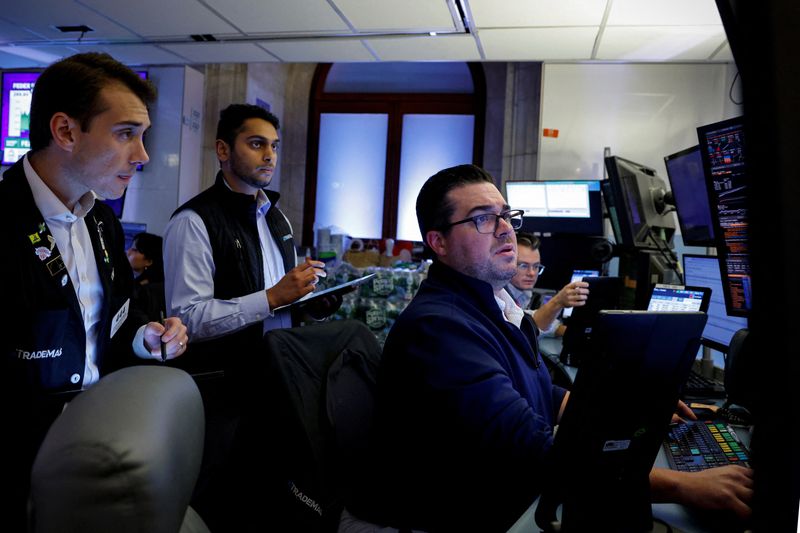By Echo Wang
(Reuters) -The Dow Jones Industrial Average and S&P 500 closed lower on Wednesday, pulling back from recent record highs driven by China's sweeping stimulus package, as investors awaited economic indicators and signals on upcoming interest rate cuts.
The three main indexes were positioned for monthly gains after the Federal Reserve's rate cut on Sept. 18 bolstered hopes for a soft landing. However, a weak consumer sentiment report on Tuesday raised concerns about the health of the labor market.
"What happened in commodities and basic materials, etc., was quite a reaction to ... 'hey, what if China can get growing again?' And that kind of feeds into other areas, (and) it helps other economies," said Tom Martin, senior portfolio manager at Globalt in Atlanta.
The long-term Treasury bond yield rose on concerns that looser financial conditions could reignite inflation. [US/]
Odds of a 50 basis point cut by the U.S. central bank at its November meeting have risen to 57.4%, from a coin toss earlier in the week, the CME Group's (NASDAQ:CME) FedWatch Tool showed.
The Dow Jones Industrial Average fell 293.47 points, or 0.70%, to 41,914.75. The S&P 500 lost 10.67 points, or 0.19%, at 5,722.26 and the Nasdaq Composite gained 7.68 points, or 0.04%, at 18,082.21.
The blue-chip Dow slipped after hitting record highs, pressured by a decline in Amgen (NASDAQ:AMGN), which reported mixed data on two drugs, sparking concerns over heightened competition.
The S&P 500 and the tech-heavy Nasdaq have risen about 20% so far this year, driven by expectations of rate cuts and optimism about artificial intelligence. However, the S&P 500 is trading at valuations significantly above long-term averages.
"Valuations are fairly high right now, sentiment is fairly high," Martin said, noting that caution is creeping in. "It's hard to find bargains out there, because everything that has gotten hit, a lot of it has come back, and the market has broadened out."
Nine out of the 11 S&P 500 sectors fell, led by energy stocks which fell 1.9%. Tech stocks bucked the trend with a 0.5% rise, supported by Nvidia (NASDAQ:NVDA)'s 2.14% gain.
Sales of new U.S. single-family homes fell in August, but declining mortgage rates and house prices could stimulate demand in the months ahead.
The focus, however, will be on weekly jobless claims and the August U.S. personal consumption expenditure (PCE) index, both set to be released later in the week.
Remarks from Fed Governor Adriana Kugler, expected after markets close, will also be closely examined. But attention will center on Fed Chair Jerome Powell's speech at the New York Treasury Market Conference on Thursday.
Apple shares (NASDAQ:AAPL) slipped 0.52% as sales of foreign-branded smartphones, including iPhones, in China fell in August on an annual basis, data from a government-affiliated research firm showed.
Citigroup, Bank of America (NYSE:BAC) and JPMorgan (NYSE:JPM) & Chase weighed on the broader bank index, which dropped 0.93%.
KB Home slipped 5.35% after posting a downbeat third-quarter profit.
Hewlett Packard Enterprise topped the S&P 500 with a 5.14% gain after Barclays (LON:BARC)' rating upgrade.
Shares of Ford and General Motors (NYSE:GM) fell over 4% after Morgan Stanley (NYSE:MS) lowered its recommendations on the automakers.
Declining issues outnumbered advancers by a 2.4-to-1 ratio on the NYSE. There were 387 new highs and 56 new lows on the NYSE.

The S&P 500 posted 36 new 52-week highs and two new lows while the Nasdaq Composite recorded 70 new highs and 110 new lows.
Volume on U.S. exchanges was 10.42 billion shares, compared with the 11.69 billion average for the full session over the last 20 trading days.